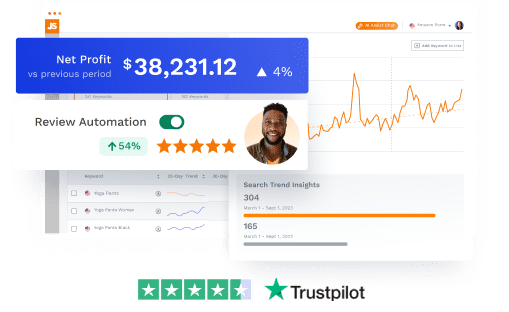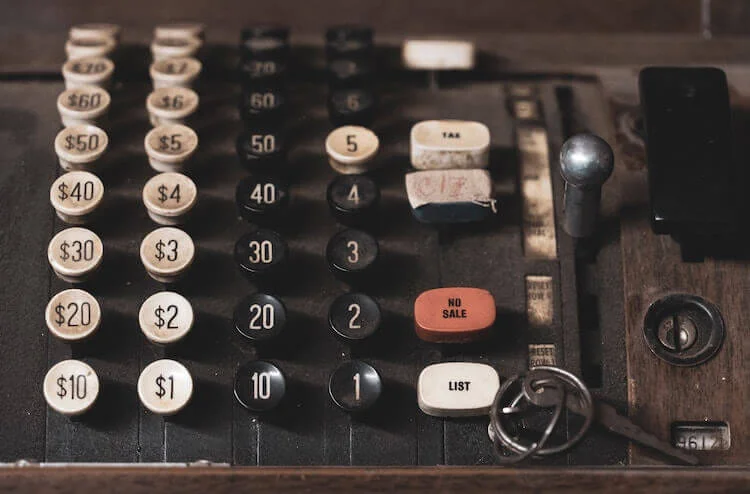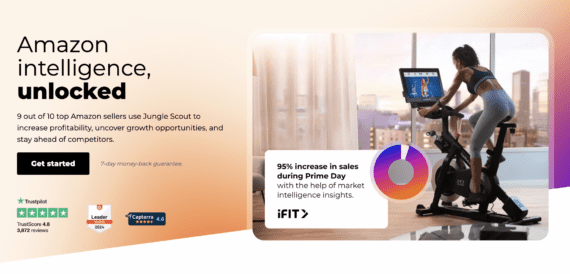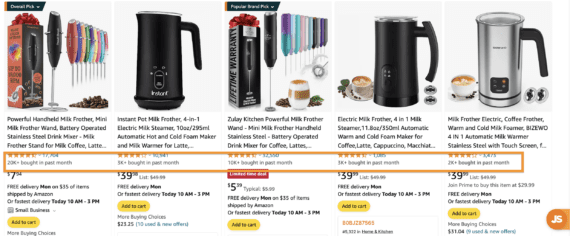Content
expand_moreRunning sponsored ads for your Amazon listings is a great way to increase sales, improve product discoverability, and grow organic rankings. An advertising presence on Amazon can potentially bring high returns and is worth the investment. To profit from advertising, however, you need to be able to measure the performance of your campaigns.
One way to measure the success of your advertising efforts is by calculating your RoAS, or return on ad spend. Amazon’s Advertising dashboard already provides you with this key metric to help you make informed business decisions, along with other metrics such as ad spend and ad sales.
So, what’s a good RoAS on Amazon? The industry says the average is around 4, but there’s more to it than that — It really depends on your profit margin. The good thing is you can figure out the exact RoAS you need in order for your ads to be profitable.
What is RoAS?
RoAS stands for Return on Advertising Spend. It’s a metric that measures how much revenue you’ve made in sales for each dollar you’ve spent on ads. Essentially, it tells you whether or not your ad campaign is working.
As a marketer on Amazon, it’s important to understand your RoAS for each product you sell. By learning how to calculate this metric, you can measure the performance of your ad campaign, find out if you’re earning revenue, and know when to make changes to your campaign to make it profitable.
How to calculate your Amazon RoAS
You can easily calculate your RoAS by dividing the total ad attributed sales by your total ad spend.

For example, if you spent $100 on Sponsored Ads and earned $500 in sales from those ads, your RoAS would be 5.
$500 in total ad attributed sales / $100 total ad spend
RoAS = 5
The higher your RoAS, the more profitable your ad campaigns. If you spent $100 on ads but only earned $100 back in sales, your RoAS would be 1. Because you earned only one dollar back for every dollar you spent on ads, your campaign is unprofitable. After you factor in your product costs and Amazon fees, you’ll be in the red.
This is a powerful metric to pay attention to. Once you know your RoAS, you can revisit your ad strategy, and make adjustments to optimize your ads. This practice allows you to improve your ads, and earn more revenue without having to spend more money.
Amazon Advertising products that produce the highest RoAS
If you advertise your products on Amazon — especially as a brand registered seller — there are three different ad types available to you. Every ad type is in PPC format, and they each serve different functions for sellers’ advertising goals. Because of this, the ad types you choose may each result in different returns on your ad spend.
How to Register Your Brand on Amazon Brand Registry
Jungle Scout examined thousands of brands and sellers to explore how they advertise on Amazon, and see which ad types result in the highest return on investment.
According to our Amazon Advertising Report, Sponsored Products ads produce the highest RoAS compared to Sponsored Brands and Sponsored Display.

This chart shows that for every $1 spent in Sponsored Products advertising, $3.67 in revenue was earned — which is a 3.67 RoAS. For many products, this type of return is very profitable.
Sponsored Brands ads come in a close second, and Sponsored Display ads are considered to yield the lowest RoAS. But this does not mean that these two ad campaign types are not worth testing out for your brand.
While Sponsored Display ads may not give you a high return on investment, they’re a great way to increase your visibility and retarget potential customers.
This ad type re-engages customers who visited your listing in the past, and they may likely convert to a sale because they’re already familiar with your listing or are looking for similar items in your category. What may not work well for another brand may work great for yours, so always test methods and see what works best for your business.
Use Jungle Scout to find profitable keywords for your advertising campaigns.
RoAS by targeting type
The type of targeting you choose for your ads will also have an impact on your RoAS.

In this example, Close match targeting results in the highest RoAS compared to the others because you’re targeting keywords that are most relevant to the customer’s search intent. But this doesn’t mean that the other targeting options are not as effective. Every product and campaign is different — test various target match types with your products and see how they perform.
Each ad type will have different targeting options to choose from. For example, if you are running a Sponsored Products campaign, you have the option to choose from automatic and manual campaigns.
Both automatic and manual campaigns have different targeting options within them. In an automatic targeting campaign, the targeting options are as follows: Close match, Loose match, Substitutes, and Complements.

In a manual campaign, you don’t have these targeting options. Instead, you can target keywords of your competitors’ products.
RoAS by product price
Yes, your product’s price also has an impact on your RoAS! We’ve found that the RoAs for products priced $20 or less increased year-over-year, while other price ranges fell.
This could be the case because it’s easier for a customer to make an impulse purchase for a lower-priced product versus a higher-priced product. Still, we believe that the $21-$30 price range is the sweet spot.
A higher-priced product does not always mean greater returns, as it may take more ad clicks to convert a sale. Not every customer is willing to spend money on products that cost over $30.

What is a good RoAS on Amazon?
What is a good RoAS on Amazon? It depends on your profit margin is — there is no one-size-fits-all number. 2x RoAS might be great for one brand but terrible for another.
If you have a small profit margin, you’re going to need a higher RoAS for your ads to be profitable. If you have a high-profit margin product, you can achieve a profit with a lower RoAS.
A good way to determine the ideal RoAS for your product is to determine your “minimum RoAS”. Once you have this number, you’ll know at a quick glance whether or not your campaigns are running profitably.
How to find your minimum RoAS
To find your minimum RoAS, calculate your break-even point. Your break-even point is what you make from a sale after the cost of goods sold (COGS), including expenditures such as unit cost, shipping fees, supply costs, and Amazon fees. That break-even number is your gross profit before advertising expenses.
Let’s use a simple example:
Product sale price: $30
COGS: $10
Amazon fees: $10
= Profit: $10
Remember that this profit is before you spend anything on advertising. If you can make a sale without advertising, great! You’ve profited $10. But assuming you need to advertise to make a sale, that $10 number is your break-even point.
If your advertising costs are $5 for one sale, you’ve made $5 net profit. If your advertising costs are $10 for one sale, then you just “broke even,” as your profit would be $0. You didn’t lose money — or make any — on the sale.
Now that we have your break-even point, let’s figure out your minimum RoAS.
To find your minimum RoAS, follow this simple formula:
Sale price / Break-even point = Minimum RoAS
Using the same example above:
$30 / $10 = 3
This means your minimum RoAS is 3x. So, for every dollar that you spend on advertising, you need to make at least $3 in revenue in order for your ads to be profitable.
If your RoAS is at or lower than 3, your ads are not profitable. Your ads are profitable if your RoAS is above 3. A “good” RoAS is subjective and will depend on the goals you want to achieve for your business.
For example, for the business that I run myself, I would consider anything over the minimum RoAS to be good, as it means my ads are running profitably. Even if the ads are barely profitable, it doesn’t mean my business isn’t. If the keywords I target are converting into sales, that ultimately helps organic keyword rankings — thus increasing organic sales.
Amazon Keyword Research: Your Guide to Success in 2024
Since my business has very low overhead, this works well for me. As long as the ads are profitable, I can work on optimizing the campaigns to increase their profitability even more.
On the flip side, another seller with a minimum RoAS of 3 may consider anything under 5 to be bad as it is not profitable enough for their business. Their business may have more overhead, such as office and warehouse rent, employee salaries, and utilities.
This shows that what works for you may not work for another Amazon seller.
Where to find your RoAS in Seller Central
Now that you have your break-even RoAS number, how do you know what your RoAS actually is? Amazon provides these metrics in each campaign you’re running and for your advertising efforts as a whole.
In Seller Central, go to Advertising > Campaign Manager.

When you first get into your dashboard, you’ll be able to see the totals of all your advertising campaigns.

In this account, the average RoAS for all your campaigns is 1.48, but you can view your RoAS for each active advertising campaign. This information is good to know so you can pause and adjust poorly performing campaigns and further optimize your best-performing ones.

For this particular campaign, you are just below your minimum RoAS number. Since you are close to breaking even, you can choose to look further into the campaign to see which keywords are not driving conversions.
Keep in mind that just because a campaign is below your “break-even point” does not mean that you need to pause it. If the campaign is still driving lots of traffic and sales to your listings, it may still be helping your overall organic rankings.
What’s a good RoAS for your business?
We hope this article helped you understand that there isn’t a magic number for a “good” RoAS on Amazon. A profitable and ideal RoAS for your product will depend on the type of product you’re selling, your product’s price point, the ad types you choose, and your profit margin.
By figuring out what your break-even RoAS is, you can make better decisions when optimizing your campaigns. If you focus on staying above that number, your advertising efforts will remain profitable.
Check out our other helpful resources on Amazon advertising:
Do you have any more questions about RoAS on Amazon? Let us know in the comments below!
Use Jungle Scout to improve your Amazon Advertising campaigns.
Brian Connolly is an Amazon seller, ecommerce expert, and writer for Jungle Scout. He lives in the New Jersey Shore area with his wife and cat. When he isn’t writing advice online for aspiring and experienced Amazon sellers for Jungle Scout, he spends his free time boating, fishing, and selling boating-themed items on his Amazon business.










